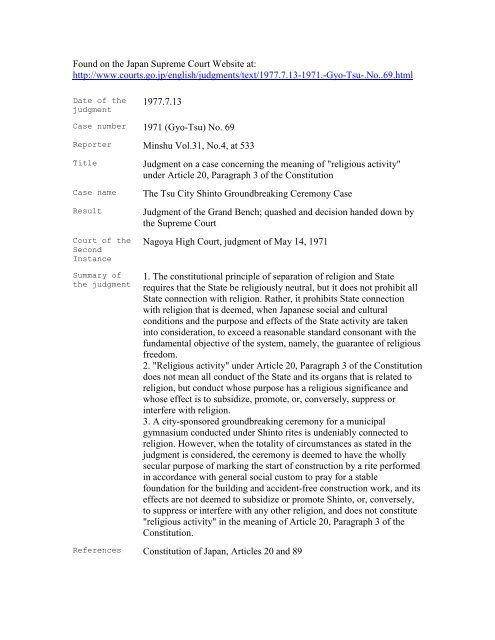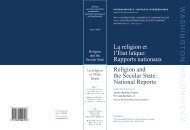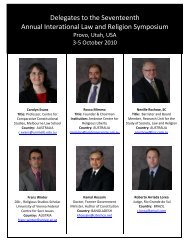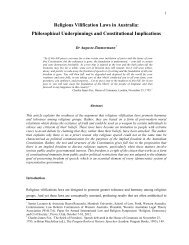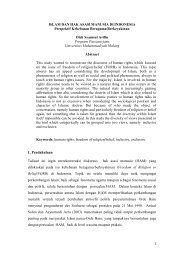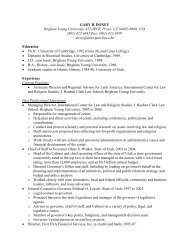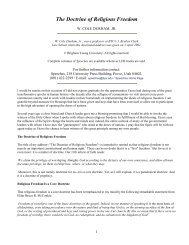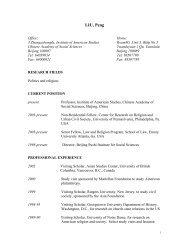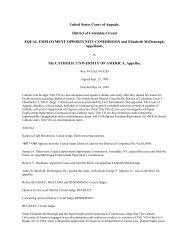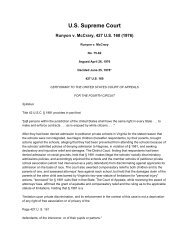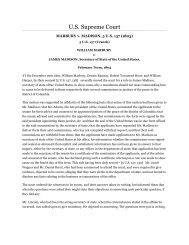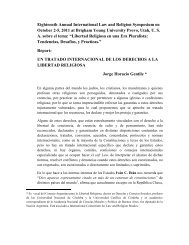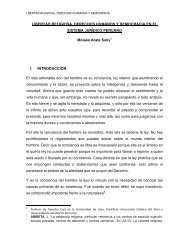Tsu City Groundbreaking Ceremony case - International Center for ...
Tsu City Groundbreaking Ceremony case - International Center for ...
Tsu City Groundbreaking Ceremony case - International Center for ...
Create successful ePaper yourself
Turn your PDF publications into a flip-book with our unique Google optimized e-Paper software.
Found on the Japan Supreme Court Website at:<br />
http://www.courts.go.jp/english/judgments/text/1977.7.13-1971.-Gyo-<strong>Tsu</strong>-.No..69.html<br />
Date of the<br />
judgment<br />
1977.7.13<br />
Case number 1971 (Gyo-<strong>Tsu</strong>) No. 69<br />
Reporter Minshu Vol.31, No.4, at 533<br />
Title<br />
Case name<br />
Result<br />
Court of the<br />
Second<br />
Instance<br />
Summary of<br />
the judgment<br />
Judgment on a <strong>case</strong> concerning the meaning of "religious activity"<br />
under Article 20, Paragraph 3 of the Constitution<br />
The <strong>Tsu</strong> <strong>City</strong> Shinto <strong>Groundbreaking</strong> <strong>Ceremony</strong> Case<br />
Judgment of the Grand Bench; quashed and decision handed down by<br />
the Supreme Court<br />
Nagoya High Court, judgment of May 14, 1971<br />
1. The constitutional principle of separation of religion and State<br />
requires that the State be religiously neutral, but it does not prohibit all<br />
State connection with religion. Rather, it prohibits State connection<br />
with religion that is deemed, when Japanese social and cultural<br />
conditions and the purpose and effects of the State activity are taken<br />
into consideration, to exceed a reasonable standard consonant with the<br />
fundamental objective of the system, namely, the guarantee of religious<br />
freedom.<br />
2. "Religious activity" under Article 20, Paragraph 3 of the Constitution<br />
does not mean all conduct of the State and its organs that is related to<br />
religion, but conduct whose purpose has a religious significance and<br />
whose effect is to subsidize, promote, or, conversely, suppress or<br />
interfere with religion.<br />
3. A city-sponsored groundbreaking ceremony <strong>for</strong> a municipal<br />
gymnasium conducted under Shinto rites is undeniably connected to<br />
religion. However, when the totality of circumstances as stated in the<br />
judgment is considered, the ceremony is deemed to have the wholly<br />
secular purpose of marking the start of construction by a rite per<strong>for</strong>med<br />
in accordance with general social custom to pray <strong>for</strong> a stable<br />
foundation <strong>for</strong> the building and accident-free construction work, and its<br />
effects are not deemed to subsidize or promote Shinto, or, conversely,<br />
to suppress or interfere with any other religion, and does not constitute<br />
"religious activity" in the meaning of Article 20, Paragraph 3 of the<br />
Constitution.<br />
References Constitution of Japan, Articles 20 and 89
A Jokoku Appeal was filed by the Appellant seeking reversal in part of<br />
the holding handed down by the Nagoya High Court on May 14, 1971,<br />
on a petition <strong>for</strong> annulment of an administrative disposition, etc., Case<br />
(Gyo-Ko) No. 8 (1967) of the Nagoya High Court. The Jokoku<br />
Appellee sought a judgment dismissing the Jokoku Appeal.<br />
Main text of<br />
the judgment<br />
Reasons<br />
The judgment in part of the Court of Appeals that found against Jokoku<br />
Appellant is quashed. The intermediate appeal of Jokoku Appellee<br />
against that part is dismissed. The costs of the intermediate appeal and<br />
of the Jokoku Appeal shall be borne by Jokoku Appellee.<br />
1. On Ground (1) <strong>for</strong> Jokoku Appeal by Appellant's attorney Horiya<br />
Yoshio:<br />
The language of the petition indicates that the original suit was brought<br />
against the Jokoku Appellant, Kakunaga Kiyoshi, in his capacity as a<br />
private individual. There<strong>for</strong>e, this Court rejects Jokoku Appellant's<br />
argument, which rests on the untenable premise that the original suit<br />
was brought against the Mayor of <strong>Tsu</strong> <strong>City</strong>.<br />
2. On the supplement to the above Ground (1) <strong>for</strong> Jokoku Appeal:<br />
The records clearly show that Jokoku Appellee completed the<br />
necessary petition <strong>for</strong> audit when he brought the original suit. This<br />
Court rejects Jokoku Appellant's argument that the Court of Appeals<br />
erred in its decision.<br />
3. On Ground (2) <strong>for</strong> Jokoku Appeal by Appellant's attorney Horiya<br />
Yoshio and Ground (4) <strong>for</strong> Jokoku Appeal by Appellant's attorney<br />
Higuchi <strong>Tsu</strong>nemichi:<br />
Clearly, an expenditure of public money is illegal not only when the<br />
expenditure itself violates Article 89 of the Constitution, but also when<br />
the reason <strong>for</strong> the expenditure is prohibited under Article 20, Paragraph<br />
3. This Court rejects Jokoku Appellant's contention since it wrongly<br />
assumes that the expenditure of public money in the present <strong>case</strong> would<br />
be illegal only if it violated Article 89 of the Constitution.<br />
4. On Ground (3) <strong>for</strong> Jokoku Appeal of Appellant's attorney Horiya<br />
Yoshio, Grounds (1) and (3) <strong>for</strong> Jokoku Appeal of Appellant's<br />
attorneys Okuno Kenichi, Tanabe <strong>Tsu</strong>nesada, and Hayasegawa<br />
Takeshi, and Grounds (1) and (3) <strong>for</strong> Jokoku Appeal of Appellant's<br />
attorney Higuchi <strong>Tsu</strong>nemichi:<br />
(a) Background of This Case<br />
(i) This <strong>case</strong> contests the legality of the expenditure by Jokoku<br />
Appellant, as Mayor of <strong>Tsu</strong> <strong>City</strong>, of the sum of 7,663 yen in municipal
public funds (4,000 yen in remuneration to Shinto priests and 3,663 yen<br />
<strong>for</strong> offerings) to hold a groundbreaking ceremony at the site of the <strong>Tsu</strong><br />
<strong>City</strong> Gymnasium in Sendo Town, <strong>Tsu</strong> <strong>City</strong>, on January 14, 1965<br />
(hereinafter "<strong>Groundbreaking</strong> <strong>Ceremony</strong>"). The city, a local public<br />
entity, sponsored the event and used city employees as ushers. The<br />
ceremony was conducted in accordance with Shinto rites and presided<br />
over by four Shinto priests, including the chief priest of Oichi Shrine,<br />
which is a religious corporation.<br />
(ii) The court of first instance ruled that the <strong>Groundbreaking</strong> <strong>Ceremony</strong><br />
is the same ceremony that has been conducted since ancient times<br />
under the name jichinsai (Shinto groundbreaking ceremony), and that<br />
while it undeniably appears to be a Shinto religious ceremony, it is<br />
actually a folk ceremony, not a religious activity <strong>for</strong> the purpose of<br />
propagating or disseminating Shinto, and there<strong>for</strong>e does not violate<br />
Article 20, Paragraph 3 of the Constitution. Further, that Court found<br />
that the payment of expenses <strong>for</strong> the <strong>Groundbreaking</strong> <strong>Ceremony</strong> was<br />
not intended to assist a particular religious organization, and that the<br />
payment of 4,000 yen to the Shinto priests, in particular, was merely a<br />
fee <strong>for</strong> services and thus did not violate Article 89 of the Constitution<br />
or Article 138, Paragraph 2 of the Local Autonomy Law.<br />
However, the Court of Appeals ruled that the <strong>Groundbreaking</strong><br />
<strong>Ceremony</strong> cannot be viewed merely as a social observance or folk<br />
ceremony but should be considered a religious rite specific to Shrine<br />
Shinto. The Court further ruled that the Constitution adopts the<br />
principle of complete separation of religion and State and declared the<br />
State to be secular with the intention of making a clear separation<br />
between the two. Accordingly, the Court of Appeals ruled that the<br />
prohibition of "religious activity" in Article 20, Paragraph 3 of the<br />
Constitution covers not only positive acts designed to propagate or<br />
disseminate a particular religion, but all acts that are expressions of<br />
religious faith, including any "religious act, celebration, rite or<br />
practice" as stipulated in Paragraph 2 of Article 20. The Court thus<br />
found that the <strong>Groundbreaking</strong> <strong>Ceremony</strong> constituted a religious<br />
activity prohibited under Article 20, Paragraph 3, and that the<br />
expenditure of public money by Jokoku Appellant as mayor was<br />
there<strong>for</strong>e illegal.<br />
(iii) Jokoku Appellant contends, in sum, that the Court of Appeals erred<br />
in determining the nature of the <strong>Groundbreaking</strong> <strong>Ceremony</strong> and the<br />
significance of the principle of religion-State separation when it held<br />
that the ceremony constitutes a religious activity prohibited under<br />
Article 20, Paragraph 3 of the Constitution, since the ceremony is<br />
merely a folk practice which, under the name jichinsai, has been<br />
traditionally accepted and per<strong>for</strong>med as a general social custom and<br />
which does not constitute a prohibited religious activity. Jokoku
Appellant contends that the Court of Appeals erred in its interpretation<br />
and application of Article 20, and that these errors clearly influence the<br />
Court's conclusion.<br />
(b) The Judgment of This Court<br />
(i) The Constitutional Principle of Separation of Religion and State<br />
The Constitution guarantees the freedom of religion in a narrow sense<br />
in the provisions "Freedom of religion is guaranteed to all" (Article 20,<br />
Paragraph 1, section 1) and "No person shall be compelled to take part<br />
in any religious act, celebration, rite or practice" (Article 20, Paragraph<br />
2). It also establishes provisions based on the principle of separation of<br />
religion and State (hereinafter "Provisions on Religion-State<br />
Separation"), viz., "No religious organization shall receive any<br />
privileges from the State, nor exercise any political authority" (Article<br />
20, Paragraph 1, section 2); "The State and its organs shall refrain from<br />
religious education or any other religious activity" (Article 20,<br />
Paragraph 3); and "No public money or other property shall be<br />
expended or appropriated <strong>for</strong> the use, benefit or maintenance of any<br />
religious institution or association . . . " (Article 89).<br />
In general, the principle of religion-State separation has been<br />
understood to mean the secularity or religious neutrality of the State; in<br />
other words, because questions of religion and faith are matters of<br />
individual conscience that transcend the dimension of politics, the State<br />
(including local public entities; the same applies hereinafter), as the<br />
holder of secular authority, should place such questions beyond the<br />
realm of public power and refrain from interfering in matters of<br />
religion. The relationship of religion and State differs between<br />
countries and is a product of their historical and social conditions. The<br />
Constitution of the Empire of Japan [1889] (hereinafter "Meiji<br />
Constitution") contained a provision that guaranteed freedom of<br />
religion (Article 28), but the same Article restricted that guarantee<br />
"within limits not prejudicial to peace and order, and not antagonistic to<br />
[the peoples'] duties as subjects." Moreover, State Shinto was virtually<br />
established as the national religion; belief therein was sometimes<br />
demanded, and certain other religious groups were severely persecuted.<br />
Thus, the Meiji Constitution's guarantee of religious freedom was<br />
incomplete.<br />
This situation changed at the end of World War II. On December 15,<br />
1945, the General Headquarters of the Supreme Commander <strong>for</strong> the<br />
Allied Powers (GHQ-SCAP) issued the "Directive on the Abolition of<br />
Governmental Sponsorship, Support, Perpetuation, Control, and<br />
Dissemination of State Shinto and Shrine Shinto" (known as the Shinto<br />
Directive) to the Japanese government. This assigned to Shrine Shinto<br />
the same legal status as other religions, and also specified concrete<br />
measures to separate all religions, including Shinto, from the State.
In light of the deleterious effects of the close ties that had existed<br />
between the State and Shinto since the Meiji Restoration, the<br />
Constitution of Japan, promulgated on November 3, 1946, guaranteed<br />
unconditional freedom of belief and further strengthened that guarantee<br />
by establishing the Provisions on Religion-State Separation.<br />
In Japan, unlike Christian or Muslim countries, various religions have<br />
developed alongside one another and coexisted on many levels. In this<br />
environment, an unconditional guarantee of religious freedom, on its<br />
own, would not be sufficient to assure freedom of belief; it was also<br />
necessary to establish the Provisions on Religion-State Separation in<br />
order to eliminate all ties between the State and religion. Thus, the<br />
Constitution should be understood as establishing the Provisions to<br />
secure State secularity and religious neutrality by adopting the ideal of<br />
complete separation of religion and State.<br />
The Provisions on Religion-State Separation are essentially an<br />
institutional guarantee; that is to say, they do not directly guarantee<br />
freedom of religion per se, but attempt to guarantee it indirectly by<br />
securing a system in which religion and the State are separate.<br />
However, religion involves more than private, personal belief; it is<br />
accompanied by a broad array of external social aspects and thus comes<br />
into contact with many sectors of social life, including education, social<br />
welfare, culture, and folk customs. As a natural result of this contact,<br />
the State cannot avoid association with religion as it regulates social<br />
life or implements policies to subsidize and support education, social<br />
welfare, or culture. Thus, complete separation between religion and<br />
State is virtually impossible in an actual system of government.<br />
Furthermore, to attempt complete separation would inevitably lead to<br />
anomalies in every area of social life. For example, it would cast doubt<br />
on the propriety of extending to religiously affiliated private schools<br />
the same subsidies that are given to nonreligious private schools, and it<br />
would call into question the propriety of State assistance to religious<br />
groups <strong>for</strong> the maintenance and preservation of cultural assets such as<br />
shrine and temple buildings, Buddhist statues, and the like. To deny<br />
such support would amount to imposing a disadvantage on these<br />
entities because of their religious affiliation; in other words, it would<br />
amount to discrimination on religious grounds. Similarly, to prohibit all<br />
prison chaplaincy activities of a religious nature would severely restrict<br />
inmates' freedom of worship. As these examples demonstrate, there are<br />
certain inherent and inevitable limits to the religion-State separation<br />
guaranteed by the Provisions. When the principle of religion-State<br />
separation is embodied in an actual system of government, given that<br />
the State must accept some degree of involvement with religion<br />
according to the particular societal and cultural characteristics of the<br />
nation, the question then becomes [a balancing of interests]: under what<br />
circumstances and to what degree can such a relationship be accepted<br />
while remaining consistent with the guarantee of religious freedom
which is the fundamental objective of the system. From this<br />
perspective, the principle of religion-State separation, which <strong>for</strong>ms the<br />
basis of the Provisions and serves to guide their interpretation, demands<br />
that the State be religiously neutral but does not prohibit all connection<br />
of the State with religion. Rather, it should be interpreted as prohibiting<br />
conduct that brings about State connection with religion only if that<br />
connection exceeds a reasonable standard determined by consideration<br />
of the conduct's purpose and effects in the totality of the circumstances.<br />
(ii) Religious Activity Prohibited by Article 20, Paragraph 3<br />
Article 20, Paragraph 3 of the Constitution stipulates that "The State<br />
and its organs shall refrain from religious education or any other<br />
religious activity." Using the above discussion of the principle of<br />
religion-State separation to interpret this language, "religious activity"<br />
should not be taken to mean all activities of the State and its organs<br />
which bring them into contact with religion, but only those which bring<br />
about contact exceeding the a<strong>for</strong>esaid reasonable limits and which have<br />
a religiously significant purpose, or the effect of which is to promote,<br />
subsidize, or, conversely, interfere with or oppose religion. The prime<br />
example of such activities is the propagation or dissemination of<br />
religion, such as religious education, which is explicitly prohibited in<br />
Article 20, Paragraph 3; but other religious activities like celebrations,<br />
rites, and ceremonies are not automatically excluded if their purpose<br />
and effects are as stated above. Thus, in determining whether a<br />
particular act constitutes proscribed religious activity, external aspects<br />
such as whether a religious figure officiates or whether the proceedings<br />
follow a religiously prescribed <strong>for</strong>m should not be the only factors<br />
considered. The totality of the circumstances, including the place of the<br />
activity, whether the average person views it as a religious act, the<br />
actor's intent, purpose, and degree (if any) of religious consciousness,<br />
and the effects on the average person, should be taken into<br />
consideration to reach an objective judgment based on socially<br />
accepted ideas.<br />
Let us now examine the relationships between Paragraphs 2 and 3 of<br />
Article 20. Both concern religious freedom in the broad sense, but<br />
Paragraph 2, which states that no person shall be compelled to take part<br />
in any religious act, directly guarantees freedom of religion in the<br />
narrow sense as well, that is, against deprivation of that freedom by the<br />
majority. Paragraph 3, on the other hand, seeks to indirectly guarantee<br />
the freedom of religion by the direct prohibition of a certain range of<br />
activities of the State or its organs, thereby guaranteeing a system that<br />
separates religion and State. As indicated above, limits inhere in the<br />
latter guarantee, which should be determined in light of the average<br />
person's attitudes since the issue is one of State involvement with<br />
religion in the social context.
As shown above, the two paragraphs differ in purpose, intent, and<br />
scope, and they guarantee different freedoms. Thus, the interpretations<br />
of "religious act," etc. in Paragraph 2 and "religious activity" in<br />
Paragraph 3 proceed from different perspectives. Not all of the acts<br />
covered by Paragraph 2 are necessarily included in the activities<br />
prohibited by Paragraph 3. Even if a particular religious celebration,<br />
rite, or ceremony is deemed not to be included in "religious activity"<br />
under Paragraph 3, if the State coerced a person to participate who<br />
would otherwise choose not to take part on grounds of religious belief,<br />
this would, of course, infringe that person's religious freedom and<br />
would violate Paragraph 2. For that reason, the above interpretation of<br />
"religious activity" prohibited under Article 20, Paragraph 3 does not in<br />
itself endanger the freedom of belief of religious minorities.<br />
(iii) The <strong>Groundbreaking</strong> <strong>Ceremony</strong><br />
We will now consider whether the <strong>Groundbreaking</strong> <strong>Ceremony</strong><br />
constitutes a "religious activity" as prohibited by Article 20, Paragraph<br />
3.<br />
As described by the Court of Appeals, the <strong>Groundbreaking</strong> <strong>Ceremony</strong><br />
was clearly a rite per<strong>for</strong>med at the start of construction of a building to<br />
pray <strong>for</strong> a stable foundation <strong>for</strong> the building and safe construction<br />
work. According to the legally relevant facts found by the Court of<br />
Appeals, the <strong>for</strong>m of the ceremony was religious. It was conducted by<br />
Shinto priests, who are professional religionists, at a ceremonial site of<br />
a special type that was set up <strong>for</strong> the occasion; the priests wore<br />
religious garments and followed a ritual specific to Shrine Shinto, using<br />
special ceremonial implements. Moreover, it can be assumed that the<br />
priests who per<strong>for</strong>med the ceremony did so out of religious conviction.<br />
Thus, the ceremony undeniably involved religion.<br />
Nevertheless, although the groundbreaking ceremonies (known as<br />
jichinsai, among other names) that are traditionally per<strong>for</strong>med at the<br />
start of construction work to pray <strong>for</strong> a stable foundation and workers'<br />
safety had religious origins in their intent to pacify the gods of the land,<br />
there can be no doubt that this religious significance has gradually<br />
waned over time. In general, although the ceremony includes prayer <strong>for</strong><br />
safety and a firm foundation at the start of construction, the<br />
proceedings have become a <strong>for</strong>mality perceived as almost completely<br />
devoid of religious meaning. Even if the ceremony is per<strong>for</strong>med in the<br />
style of an existing religion, as long as it remains within the bounds of<br />
well-established and widely practiced usage, most people would<br />
perceive it as a secularized ritual without religious meaning, a social<br />
<strong>for</strong>mality that has become customary at the start of construction work.<br />
Although the <strong>Groundbreaking</strong> <strong>Ceremony</strong> was conducted as a Shrine<br />
Shinto rite, <strong>for</strong> most citizens, and <strong>for</strong> the Mayor of <strong>Tsu</strong> <strong>City</strong> and others<br />
involved in sponsoring the event, it was a secular occasion with no
particular religious meaning, because such a ceremony is well within<br />
the bounds of general usage widely observed over many years.<br />
Furthermore, in actual practice, the construction workers themselves<br />
who are particularly concerned with safety consider it indispensable, as<br />
a general custom, to mark the start of work with a ceremony sponsored<br />
or attended by the owner of the building and including a ritual like the<br />
one in this <strong>case</strong>. In light of this practice, together with the public<br />
attitudes discussed above, it is clear that the building owner had a very<br />
secular motive <strong>for</strong> holding the customary groundbreaking ceremony:<br />
meeting the demand of construction workers to observe a social<br />
<strong>for</strong>mality that has become customary at the start of work, thereby<br />
ensuring its smooth progress. Since there were no special<br />
circumstances affecting the <strong>Groundbreaking</strong> <strong>Ceremony</strong>, there is no<br />
reason to assume that the motive of the Mayor of <strong>Tsu</strong> <strong>City</strong> and others<br />
involved in sponsoring the event was any different from the typical<br />
motive of building owners described above.<br />
The Japanese public in general does not display a great interest in<br />
religion. They reveal, instead, a mixed religious consciousness: as<br />
members of the community, many people are believers in Shinto, and<br />
as individuals, believers in Buddhism. They feel no particular<br />
inconsistency in using different religions on different ceremonial<br />
occasions. Furthermore, Shrine Shinto is characterized by its close<br />
attention to ceremonial <strong>for</strong>m and the virtual absence of outreach<br />
activities such as the active proselytizing seen in other religions. These<br />
circumstances taken together with the public attitude to groundbreaking<br />
ceremonies discussed above render it unlikely that a groundbreaking<br />
ceremony at a construction site, even when per<strong>for</strong>med by Shinto priests<br />
according to the rituals of Shrine Shinto, would raise the religious<br />
consciousness of those attending or of people in general, or that it<br />
would have the effect of assisting, fostering, or promoting Shinto. This<br />
is equally true even when the sponsor of such a ceremony is the State,<br />
acting in the same capacity as a private citizen. It is inconceivable that<br />
such sponsorship would result in the development of a special<br />
relationship between the State and Shrine Shinto, or that it would<br />
ultimately lead to Shinto regaining the status of a State religion, or<br />
otherwise threaten religious freedom.<br />
Considering the totality of the circumstances, although the<br />
<strong>Groundbreaking</strong> <strong>Ceremony</strong> is undeniably connected with religion, we<br />
deem it to be a secular ceremony conducted in accordance with general<br />
social custom at the start of construction work to ensure a stable<br />
foundation and workers' safety. Its effects do not subsidize or promote<br />
Shinto, or, conversely, suppress or interfere with any other religion.<br />
There<strong>for</strong>e, it does not constitute prohibited religious activity under<br />
Article 20, Paragraph 3 of the Constitution.<br />
(iv) Summation:
The Court of Appeals erred in interpretation and application of Article<br />
20, Paragraph 3 of the Constitution when it reached a determination<br />
different from the above. Since those errors clearly influence the<br />
Court's conclusion, Jokoku Appellant's argument is reasonable.<br />
5. Conclusion<br />
Accordingly, the portion of the judgment of the Court of Appeals that<br />
found against Jokoku Appellant should be quashed. Regarding that<br />
portion, this Court determines as follows: As stated above, the<br />
<strong>Groundbreaking</strong> <strong>Ceremony</strong> does not in any manner violate Article 20,<br />
Paragraph 3 of the Constitution, nor does it violate the second section<br />
of Paragraph 1 of Article 20, since it does not accord any privilege to a<br />
religious organization. Further, in light of the purpose and effects of the<br />
<strong>Groundbreaking</strong> <strong>Ceremony</strong>, the nature and amount of the expenses<br />
disbursed, and other factors, the payment of ceremony expenses cannot<br />
be regarded as assistance from public funds <strong>for</strong> a particular religious<br />
organization or religious group; it there<strong>for</strong>e does not violate Article 89<br />
of the Constitution, nor does it violate Article 2, Paragraph 15 or<br />
Article 138, Paragraph 2 of the Local Autonomy Law. The petition of<br />
Jokoku Appellee against Jokoku Appellant, which is based on the<br />
premise that the payment is illegal, is thus unsustainable and is<br />
dismissed. This Court affirms the judgment of the court of first<br />
instance, which reached the same conclusion. The portion of the<br />
intermediate appeal finding against Jokoku Appellant is dismissed.<br />
There<strong>for</strong>e, in accordance with Article 7 of the Administrative<br />
Litigation Law, Articles 408, 396, and 384 of the Code of Civil<br />
Procedure, and, with regard to liability <strong>for</strong> the costs of the proceedings,<br />
Articles 96 and 89 of the Code of Civil Procedure, this Court finds as<br />
stated in the Main Text of the Judgment above. The dissenting opinion<br />
of Justices FUJIBAYASHI Ekizo, YOSHIDA Yutaka, DANDO<br />
Shigemitsu, HATTORI Takaaki, and TAMAKI Shoichi follows. The<br />
supplementary dissenting opinion of Justice FUJIBAYASHI Ekizo<br />
follows the main dissenting opinion.<br />
DISSENTING OPINION OF JUSTICES FUJIBAYASHI EKIZO,<br />
YOSHIDA YUTAKA, DANDO SHIGEMITSU, HATTORI<br />
TAKAAKI, AND TAMAKI SHOICHI<br />
1. The Constitutional Principle of Separation of Religion and State<br />
Freedom of religion is the matrix from which the spiritual and<br />
intellectual freedoms of modern humanity have developed. This<br />
important basic human right was a precursor of other civil liberties and<br />
<strong>for</strong>med the nucleus thereof. As a fundamental principle of the life of
the spirit, it is universally guaranteed by the constitutions of modern<br />
nations. In Japan, the Constitution attempts to provide a complete<br />
guarantee of religious freedom. The first section of Paragraph 1 of<br />
Article 20 states unconditionally, "Freedom of religion is guaranteed to<br />
all." The second section of Paragraph 1 then prohibits the granting of<br />
any privileges to or the exercise of any political authority by religious<br />
organizations; Paragraph 2 prohibits compulsory participation in<br />
religious activities; Paragraph 3 prohibits the State and its organs from<br />
engaging in religious activity; and Article 89 prohibits financial aid to<br />
any religious organization or group.<br />
A declaration of unconditional religious freedom is insufficient by<br />
itself to guarantee that freedom. To accomplish that guarantee it is<br />
essential, above all, to sever all ties between religion and State. As long<br />
as such ties exist, there is a great risk that they will lead either to<br />
religious influence over the State or, conversely, to State interference in<br />
religious matters and, ultimately, suppression of religious dissent and<br />
violation of the freedom of belief. This risk is clearly illustrated by the<br />
history of Japan since the Meiji Restoration.<br />
In the first year of the Meiji Period (1868), the new government<br />
proclaimed the unity of religious ritual and government administration.<br />
It reinstated the classical Office of Shinto Worship and announced a<br />
plan to establish Shinto as the State religion, whereby all the shrines<br />
and Shinto priests in Japan were placed under direct government<br />
control. It then issued a series of orders <strong>for</strong> the separation of Shinto and<br />
Buddhism, which were designed to purify Shinto and make it<br />
independent while attacking Buddhism. Meanwhile, the government<br />
maintained virtually unchanged the Tokugawa shogunate's policy of<br />
suppression of Christianity.<br />
In 1870, the government issued the Proclamation of the Great Doctrine,<br />
which declared the "way of the gods" [as the guiding principle of the<br />
State]. In 1872, the Ministry of Religion appointed Shinto priests to the<br />
Agency <strong>for</strong> Spiritual Guidance and issued "three rules <strong>for</strong> teaching": (1)<br />
Observe a spirit of reverence <strong>for</strong> the gods and love of country; (2)<br />
Reveal the laws of nature and the way of humanity. (3) Revere the<br />
Emperor and obey the Imperial court. The government thus<br />
promulgated a political ideology imbued with religious character,<br />
centered on Emperor worship and belief in Shrine Shinto, and took<br />
steps to have the people instructed therein.<br />
In 1871, the government declared that shrines were sites <strong>for</strong> the<br />
observance of "national rites" and were not the private property of<br />
individuals or families (Grand Council of State Decree No. 234). In the<br />
same year, it issued the Grand Council of State Decree No. 235,<br />
"Allocations <strong>for</strong> Government Shrines and Other Shrines and<br />
Employment Regulations, Etc., <strong>for</strong> Shinto Priests," which established a<br />
ranking system <strong>for</strong> all the shrines in Japan (except Ise Shrine). Shrines<br />
were divided into kansha or public shrines (Imperial household shrines
and national shrines) and shosha or miscellaneous shrines (urbanprefectural,<br />
domain [han], prefectural, and village shrines). The decree<br />
also gave Shinto priests the status of public officials, a privilege not<br />
accorded to other religions. In 1875, the government prohibited joint<br />
Shinto-Buddhist proselytizing and ordered each religious sect to<br />
proselytize independently. While giving verbal assurances to Shinto<br />
and Buddhist sects that it would allow freedom of belief, in 1882 the<br />
government abolished the status of Shinto priests as officials of the<br />
Agency <strong>for</strong> Spiritual Guidance and ordered them to cease officiating at<br />
funerals (Ministry of Home Affairs Notices [Otsu] No. 7 and [Tei] No.<br />
1). By requiring Shrine Shinto to engage solely in ritual observances,<br />
the government was able to adopt the official position that it was not a<br />
religion, and on that basis it consolidated a system which, in effect,<br />
established it as the national religion or State Shinto.<br />
Article 28 of the Meiji Constitution (promulgated in 1889) guaranteed<br />
the freedom of religion, but only "within limits not prejudicial to peace<br />
and order, and not in conflict with [the peoples'] duties as subjects."<br />
The Meiji Constitution's guarantee of religious freedom was far from<br />
complete, <strong>for</strong> although the law officially countenanced no state religion<br />
and accorded legal equality to all religions, State Shintoism had<br />
actually already been established, which effectively gave Shrine Shinto<br />
the status of a national religion, as described above, and citizens were<br />
expected to worship at and revere shrines as a civil duty.<br />
Furthermore, Law No. 24 of 1906, the Law Concerning Expenses of<br />
Imperial Household Shrines and National Shrines, stipulated that the<br />
national treasury would be responsible <strong>for</strong> those expenses, and Imperial<br />
Ordinance No. 96 of 1906, "Matters Concerning the Costs of Offerings<br />
by Urban-Prefectural and Lower-Ranking Shrines," stipulated that local<br />
public bodies would finance the costs of the ritual offerings of food,<br />
drink, cloth, and paper made by local shrines. Thus, the shrines were<br />
also made financially dependent on the State or local public entities.<br />
The de facto status of Shrine Shinto as a State religion, there<strong>for</strong>e, was<br />
maintained until Japan's defeat in 1945. During that period, other<br />
religious groups such as Omoto, Hitonomichi, Soka Kyoiku Gakkai<br />
[the prewar name of Soka Gakkai], and the United Church of Christ in<br />
Japan were subjected to strict governmental control and repression.<br />
Religions were officially sanctioned only insofar as they did not<br />
conflict with the concept of a State Shinto-centered "national polity."<br />
Worship at shrines was, in effect, compulsory; not only was this an<br />
egregious violation of the freedom of religion guaranteed under the<br />
Meiji Constitution, but State Shinto also <strong>for</strong>med the spiritual basis of<br />
militarism.<br />
On December 15, 1945, GHQ-SCAP issued the "Directive on the<br />
Abolition of Governmental Sponsorship, Support, Perpetuation,<br />
Control, and Dissemination of State Shinto and Shrine Shinto" (the<br />
Shinto Directive) to the Japanese government, ordering the complete
separation of Shrine Shinto from the State and specifying concrete<br />
measures toward that end. Shrine Shinto was to be placed on the same<br />
legal standing as all other religions; thus, all religions, including<br />
Shinto, were to be separated from the State. There was to be no further<br />
special protection and supervision of Shinto by the State and public<br />
officials, nor public financial aid to Shinto and its shrines. Household<br />
altars and other physical symbols of State Shinto were banned from<br />
public facilities.<br />
The Constitution of Japan incorporated the ideas of the Shinto<br />
Directive in contemplation of the bitter experience of the harmful<br />
effects of close association between the State and Shinto under the<br />
Meiji Constitution's guarantee of religious freedom. That guarantee, as<br />
shown above, was incomplete despite the importance of freedom of<br />
belief as a basic human right. The separation of religion and State is<br />
essential to secure that right. Thus, in addition to the unconditional<br />
guarantee of religious freedom in the first section of Paragraph 1,<br />
Article 20, the Constitution of Japan adopted the provisions cited above<br />
to secure a complete guarantee.<br />
Reviewing the above history, the principle of religion-State separation<br />
embodied in the second section of Paragraph 1 and Paragraph 3 of<br />
Article 20 and in Article 89 would require absolute separation. In other<br />
words, the State should be secular: religion and the State are mutually<br />
independent with no connecting ties, and the State neither allows<br />
religious influence in its affairs nor interferes in religious matters.<br />
The Majority Opinion holds that complete separation of religion and<br />
State is merely an unrealizable ideal. It argues that attempting a<br />
complete separation will result in anomalies in all areas of social life,<br />
and claims that there is an inherent limit to the extent of separation<br />
guaranteed by the Provisions on Religion-State Separation. It argues,<br />
further, that while the separation principle requires State neutrality, it<br />
does not require the State to refrain from all contact with religion. In<br />
the majority's narrow interpretation, conduct that brings connection<br />
with religion is proscribed if that connection, when considered in the<br />
totality of circumstances, is deemed to exceed a standard of<br />
reasonableness based on Japanese social and cultural conditions.<br />
The problem with this approach, however, is that the meaning of State<br />
connection with religion in the Majority Opinion is not entirely clear,<br />
and it is also unclear when such contact would exceed reasonable<br />
limits. In our opinion, the majority's interpretation of the separation<br />
principle poses the danger that State-religion ties will be readily<br />
tolerated and the guarantee of religious freedom itself will be<br />
weakened. Furthermore, from our perspective of an absolute separation<br />
of religion and State, no anomalies would arise if such a separation<br />
were attempted, since activities, like those cited by the majority, which<br />
it claims would be prohibited leading to anomalies in all areas of<br />
society, would in fact be permissible when interpreted under the
principle of equality and other constitutional requirements.<br />
2. Religious Activity Prohibited by Article 20, Paragraph 3 of the<br />
Constitution<br />
Article 20, Paragraph 3 of the Constitution states, "The State and its<br />
organs shall refrain from religious education or any other religious<br />
activity." Given the significance of religion-State separation described<br />
above, the definition of "religious activity" here should not be limited<br />
to dissemination of religious doctrines, cultivation of converts, and the<br />
like, but also, as a matter of course, should include the act of holding<br />
religious celebrations, ceremonies, or rites. The definition should not<br />
be restricted as the majority contends. Religious celebrations,<br />
ceremonies, and rites are expressions of religious faith, and sponsorship<br />
of such activities by the State or its organs is clearly contrary to the<br />
State secularism signified by the principle of religion-State separation;<br />
inquiry into the concrete effects of the activity is not necessary, as the<br />
majority contends. However, this is not to deny that, in certain<br />
instances, the State or its organs may undertake what could be deemed<br />
to constitute religious activity, either because failure to do so would<br />
restrict citizens' religious freedom or because it is enjoined by<br />
constitutional principles such as equality be<strong>for</strong>e the law.<br />
Even from the above standpoint, it is true that Article 20, Paragraph 3<br />
would not prohibit a ceremony or rite which had religious origins but<br />
which, over time, had completely lost its religious meaning and<br />
coloration and become a purely secular custom. But even customary<br />
observances that retain their religious nature, that is, religious<br />
customary observances, should naturally be included in the category of<br />
prohibited religious activity. (Interpreting and applying Article 20,<br />
Paragraph 3 as described above should essentially determine whether a<br />
custom is secular, not testing whether it meets the ethnological<br />
definition of a custom as stated by the Court of Appeals.)<br />
3. The Nature of the <strong>Groundbreaking</strong> <strong>Ceremony</strong><br />
Based on the above, we will now examine whether the <strong>Groundbreaking</strong><br />
<strong>Ceremony</strong> constitutes religious activity prohibited under Article 20,<br />
Paragraph 3 of the Constitution.<br />
(a) The legally relevant facts found by the Court of Appeals are<br />
outlined as follows.<br />
(i) At the site of the <strong>Groundbreaking</strong> <strong>Ceremony</strong>, two tents were<br />
erected. Chairs <strong>for</strong> the attendees were placed in rows inside the front<br />
tent, while red and white curtains surrounded the rear tent, sacred<br />
bamboo was placed at its corners, and sacred ropes were hung around it
on three sides to mark the ceremonial area. At the center rear of that<br />
area, an altar consisting of a plain wood table bearing ritual offerings to<br />
the gods was erected. A wooden food-offering stand bearing fruit and<br />
the like was placed at the front of the area. Sacred branches were<br />
placed on a table to the left be<strong>for</strong>e the altar, while the sacred<br />
implements of sprays of the sakaki tree, a sickle, and a hoe, were<br />
placed on a table to the right. Also, upright stems of dry bamboo were<br />
inserted in an area of raked sand at the front left of the altar; in front of<br />
this area, the order of ceremonies was displayed.<br />
(ii) At the site entrance, a city employee poured water on the hands of<br />
each attendee from a ladle decorated with paper ties and ceremonial<br />
paper wrapped around its handle, in what is known as a "hand-washing<br />
ceremony" (the minimum purification rite in Shinto). The attendees<br />
then entered the site of the ceremony.<br />
(iii) The <strong>Groundbreaking</strong> <strong>Ceremony</strong> commenced at 10 A.M., with <strong>Tsu</strong><br />
<strong>City</strong> employee Ito Yoshiharu serving as master of ceremonies.<br />
Miyazaki Kisshu, the chief priest of Oichi Shrine, which is a religious<br />
corporation and the local tutelary shrine, officiated in the following<br />
Shinto ritual, assisted by three other Shinto priests, all wearing the<br />
prescribed robes and using ceremonial implements specific to shrines.<br />
The priests conducted various rituals be<strong>for</strong>e the assembled participants:<br />
they per<strong>for</strong>med a ritual waving of sakaki branches to purify them; they<br />
bowed be<strong>for</strong>e the altar and called on divine spirits including Oichi<br />
Hime-no-mikoto, the main god of Oichi and its tutelary deity, to<br />
descend to the offerings placed there; they presented offerings of fruit<br />
and other foods. The officiating priest then stood be<strong>for</strong>e the altar and<br />
read aloud a congratulatory address praying to the divine spirits <strong>for</strong> the<br />
safe completion of the construction work. The site was then ritually<br />
purified and offerings of rice were scattered. The Mayor per<strong>for</strong>med a<br />
ritual gesture of cutting the dry bamboo with the sickle, representing<br />
the clearing of wasteland, and the official in charge of construction<br />
inserted the hoe in the sand, a ritual gesture that represents the leveling<br />
of wasteland. Then, one by one, the Mayor, President of the Municipal<br />
Assembly, and others came be<strong>for</strong>e the altar, offered sakaki sprigs that<br />
were handed to them by a priest, clapped their hands and bowed. The<br />
food offerings were then removed from the altar, and a ritual was<br />
per<strong>for</strong>med inviting the gods to return to the heavens.<br />
The attendees then bowed, the ceremony ended on schedule at<br />
approximately 10:45 A.M., and all proceeded to an adjacent tent on the<br />
western side <strong>for</strong> a celebratory banquet known in Shinto as a naorai.<br />
(ii) It is clear from the above that the groundbreaking was a religious<br />
ceremony conducted according to rituals distinctive to Shrine Shinto<br />
and presided over by a Shinto priest. Setting aside questions of
nomenclature, it is true in general that ceremonies to mark the start of<br />
construction work have been conducted <strong>for</strong> many years and have<br />
become largely secularized over time. However, as can be seen above,<br />
the <strong>Groundbreaking</strong> <strong>Ceremony</strong> itself had a very strong religious<br />
atmosphere; it cannot possibly be considered a secular convention.<br />
Moreover, even if we consider the concrete effects of the ceremony as<br />
the majority did, it is obvious that a local public entity's sponsorship of<br />
such an event results in preferential treatment and subsidization of<br />
Shrine Shinto. If such activities are condoned, there is a clear risk of a<br />
close relationship developing between local public entities and Shrine<br />
Shinto. We cannot agree with the majority, which admitted the<br />
ceremony's religious connection and did not deny its religious nature,<br />
but which treated its religious significance lightly and underestimated<br />
its effects. In our opinion, the <strong>Groundbreaking</strong> <strong>Ceremony</strong> clearly<br />
constitutes religious activity under Article 20, Paragraph 3. Moreover,<br />
there are absolutely no grounds as described above <strong>for</strong> allowing such<br />
activity in this <strong>case</strong>. The <strong>Groundbreaking</strong> <strong>Ceremony</strong> there<strong>for</strong>e violates<br />
Article 20, Paragraph 3 of the Constitution and should not be permitted.<br />
(d) Conclusion<br />
The <strong>Groundbreaking</strong> <strong>Ceremony</strong> violates Article 20, Paragraph 3 of the<br />
Constitution. The judgment to that effect by the Court of Appeals was<br />
correct and the Jokoku Appeal should be dismissed.<br />
SUPPLEMENTARY DISSENTING OPINION OF JUSTICE<br />
FUJIBAYASHI EKIZO<br />
1. The State and Religion<br />
The freedom of religion is a great principle of modern democratic<br />
states; it is the quintessence of a spirit of tolerance striven <strong>for</strong> and won<br />
through centuries of political and intellectual conflict. In the historical<br />
process of establishing religious freedom, the separation of religion and<br />
State has come to be considered its indispensable prerequisite. The<br />
principle of religion-State separation consists of two main points:<br />
(a) The State should neither bestow special financial or institutional<br />
support nor impose special restrictions on any religion. In other words,<br />
the State should adopt an equally neutral attitude toward all religions.<br />
(b) The State should not interfere in any way in the religious beliefs of<br />
its citizens. Religious belief should be left to the freedom of each<br />
individual. Whether to believe in a religion, and which religion, if any,<br />
are matters of private choice to be decided by each citizen individually.<br />
With the establishment of these fundamental principles, ties between<br />
the State and a particular religion have come to be rejected, and the<br />
State is required to concern itself solely with secular matters. However,<br />
this does not completely eliminate problems of the State's relationship
with religion. All States have a spiritual or conceptual foundation <strong>for</strong><br />
their existence, and because religion, too, is a product of the human<br />
spirit, the State, while recognizing the principle of religious freedom,<br />
must not itself be indifferent or insensible to religion. The principle of<br />
religious freedom is not a sign of State disregard <strong>for</strong> religion; on the<br />
contrary, it must spring from respect <strong>for</strong> religion.<br />
The existence of the State must be based on truth, and the truth must be<br />
protected. However, it is not the State that determines what the truth is,<br />
nor is it the people. No matter how democratic the age we live in, no<br />
one would consider the truth something to be decided by a majority<br />
vote of the people. What is true is determined by truth itself, and it is<br />
proven true by history, by the long experience of humankind. The truth<br />
is its own evidence, but it is not affirmed as true simply by an assertion<br />
that it is true. Humanity can confirm the truth only by means of history.<br />
For religion, also, we must say that truth is self-evident. Thus, a true<br />
religion can and should stand without support from the State or other<br />
secular authority. In matters of religion, it is precisely this<br />
independence which should be respected.<br />
2. The Democratization of Religion<br />
The "Shinto Directive" of GHQ-SCAP concerning State Shinto and<br />
Shrine Shinto contained three important points which became the<br />
foundations of Article 20 of the Constitution:<br />
(a) It recognized shrines as religious in nature. There is, admittedly,<br />
some room <strong>for</strong> doubt as to whether this is completely consistent with<br />
the popular sentiment of the Japanese people. Shrine Shinto has little of<br />
the thought system characteristic of a religion; in many respects, it<br />
expresses simple folk feelings about life. However, some shrine rituals<br />
and acts per<strong>for</strong>med by Shinto priests can be recognized as religious<br />
ceremonies, and that is the issue in the present <strong>case</strong>.<br />
(b) Since Shrine Shinto was deemed to be a religion, the Directive<br />
ordered that State administrative and financial protection of shrines be<br />
abolished in keeping with the principle of separation of religion and<br />
State.<br />
(c) It was understood that once Shrine Shinto was thus separated from<br />
the State, the people were free to believe in it as a religion.<br />
After the Meiji Restoration (1868), as the government set out to<br />
construct a new Japan, it imported institutions and culture from the<br />
West, but as a spiritual foundation it relied on Japan's ancient way of<br />
the gods. Having launched its modernization campaign in this<br />
disorganized fashion, the government then decided, merely <strong>for</strong> reasons<br />
of international and domestic convenience, that Shrine Shinto did not<br />
constitute a religion, so as not to infringe religious freedom, while in<br />
actual fact according it the status of a national religion. Thereafter,
political affairs and education in Japan were conducted in line with this<br />
policy. Regardless of the personal beliefs of the individuals concerned,<br />
it became customary <strong>for</strong> newly appointed Ministers of State to worship<br />
at Ise Shrine; local public officials were ordered to take part as Imperial<br />
messengers in the major festivals of Imperial household shrines and<br />
national shrines; school groups, led by teachers, visited shrines <strong>for</strong><br />
worship; and local residents, as people under the protection of their<br />
community deity, were asked to make donations <strong>for</strong> shrine festivals.<br />
These requirements were, in general, accepted peacefully as customary<br />
practices <strong>for</strong> the following reasons:<br />
(a) Shrine Shinto was a simple religion. It had no organized theology;<br />
its view of the divine was elemental, and it had very few supernatural<br />
or miraculous components. Generally speaking, all is nature and the<br />
human. Because of this simplicity, the general public readily accepted<br />
shrine worship, since it was not perceived as something that infringed<br />
the principle of religious freedom.<br />
(b) Historically, there had been few conflicts between Japanese<br />
Buddhism and Shrine Shinto, either in matters of theory or in daily life;<br />
on the contrary, they had coexisted side by side, cooperating and<br />
intermingling. The doctrine that the Japanese gods were incarnations of<br />
Buddhas and bodhisattvas provided a theoretical basis <strong>for</strong> the harmony,<br />
unity, and coexistence of the deities of the two religions. Some<br />
Buddhist temples had shrines dedicated to a Shinto guardian deity<br />
within their grounds, and most Japanese were, at the same time, both<br />
Buddhists and parishioners of their local Shinto shrine. In other words,<br />
they were content to believe in Buddhism as individuals and worship at<br />
shrines as a people, without finding this duality strange in any way.<br />
This was due partly to the missionary policies of Buddhism and partly,<br />
as stated above, to the simple religious nature of shrines. In any <strong>case</strong>, a<br />
thousand years leading a dual life combining Buddhism and Shrine<br />
Shinto meant the Japanese peoplehad little difficulty accepting the<br />
State's policy toward Shrine Shinto after the Meiji Restoration.<br />
(c) The religious consciousness of the Japanese people developed<br />
within a tradition of Shrine Shinto and Buddhism and was there<strong>for</strong>e not<br />
sufficiently sensitive to the question of religious freedom. As the two<br />
religions are polytheistic or pantheistic, not monotheistic like<br />
Christianity with its personal God, they did not encourage a sense of<br />
the individual person or stimulate the development of concepts of basic<br />
human rights. Thus, they did little to raise awareness of the importance<br />
of religious freedom. This historical circumstance is probably a major<br />
reason why the issue of shrine worship was not viewed as a serious<br />
infringement of the freedom of religion.<br />
3. Religious Activities Prohibited under Article 20, Paragraph 3 of the<br />
Constitution
The First Amendment of the United States Constitution ("Congress<br />
shall make no law respecting an establishment of religion, or<br />
prohibiting the free exercise thereof; . . .") was probably the greatest<br />
influence on the enactment of Paragraphs 1 and 3 of Article 20 of the<br />
Constitution of Japan. The provisions in the Japanese Constitution go<br />
even further in their proclamation of the principles of religious freedom<br />
and separation of religion and State and indeed are so exhaustive that<br />
there is nothing comparable among the constitutions of the world.<br />
Paragraph 3 provides, "The State and its organs shall refrain from<br />
religious education or any other religious activity." When the<br />
significance of the principle of separation of religion and State, which<br />
should be the guiding standard <strong>for</strong> interpreting this paragraph, is<br />
considered, the provision should be construed as <strong>for</strong>bidding the State<br />
and its organs from engaging in any activity that has a religious<br />
meaning, not only positive activities with a religious purpose, such as<br />
disseminating a religion or cultivating believers, but also religious<br />
celebrations, ceremonies, and rites. The substantive reasons <strong>for</strong> thus<br />
broadly construing the meaning of religious activity are as follows.<br />
It is said that virtually no people known to history has been without a<br />
religion. Of course, "religion" does not necessarily mean the same to<br />
scholars of religion or religious history as it does to scholars of law.<br />
Over the ages, theologians, philosophers, and those who study religions<br />
scientifically have offered so diverse an array of definitions of religion<br />
that there are said to be as many definitions as there are scholars.<br />
Hence, it is hardly surprising that "religion" is not defined anywhere in<br />
the laws of Japan.<br />
In the United States, also, not only is there no definition of "religion" or<br />
"religious" in the Constitution, but the Supreme Court has not defined<br />
those terms when dealing with various religions or religion-like<br />
entities. Instead, it has been satisfied with stating that, whatever the<br />
meaning of these words, the First Amendment does not prohibit<br />
governmental conduct that intervenes in acts that interfere with duties<br />
to society or destroy good order. In other words, the U.S. Supreme<br />
Court found that because law is created to control acts, law cannot<br />
interfere in religious belief or opinions as such, but it can control<br />
religious activity. To put this another way, the Court decided to treat all<br />
religions and religion-like entities as religions under the Constitution,<br />
but to deal only with their external manifestations. (Cf. [ORIGINAL<br />
CHAPTER TITLE NOT CONFIRMED: "What Is a Religion?"] in<br />
Konvitz, Milton R. Religious Liberty and Conscience: A Constitutional<br />
Inquiry, New York, 1968.)<br />
In my opinion, the words "religion" and "religious" in our Constitution<br />
also should be interpreted as broadly as possible. When these terms are<br />
strictly defined or narrowly construed, the guarantee of Article 20 does<br />
not to extend to other religious acts or other acts of an analogous<br />
nature; this not only results in severe restriction of religious freedom,
ut also opens the way to close ties between religion and State.<br />
4. The Nature of the <strong>Groundbreaking</strong> <strong>Ceremony</strong> at Issue<br />
The Majority Opinion recognizes that a groundbreaking ceremony is a<br />
rite to pray <strong>for</strong> accident-free construction work, etc., and that it includes<br />
the act of prayer. But it states that in the present day, both to average<br />
citizens and to the sponsors of a groundbreaking, it is a secular<br />
ceremony because it has become a mere <strong>for</strong>mality accompanying the<br />
construction of a building. In other words, the majority consider it a<br />
customary practice.<br />
Of course, we must recognize that there are various observances which<br />
were originally religious but which no longer have any religious<br />
meaning in society. The Japanese still place New Year's pine<br />
decorations outside their gates to bring good luck, although the custom<br />
seems to be declining year by year. We can also readily accept that<br />
customs like the Dolls' Festival and Christmas trees are meaningful as<br />
family treats that parents provide <strong>for</strong> children, or as observances to<br />
foster goodwill within a group. These customs have probably lost all<br />
religious significance.<br />
But can we regard the per<strong>for</strong>mance of the <strong>Groundbreaking</strong> <strong>Ceremony</strong><br />
under the circumstances described by the Court of Appeals merely as a<br />
way of bringing good luck or a <strong>for</strong>m of entertainment? As the majority<br />
notes, those who are involved in the building work and who are thus<br />
particularly concerned with safety consider it indispensable to hold a<br />
groundbreaking ceremony incorporating rites as in this <strong>case</strong>, and the<br />
sponsors comply with this demand, regardless of their own wishes, to<br />
ensure the smooth progress of the work. It is inconceivable that the<br />
ceremony in the present <strong>case</strong> was held merely <strong>for</strong> the sake of the<br />
banquet that traditionally follows it. Something is here that cannot be<br />
understood in terms of mere customary practice. In other words, if<br />
consideration <strong>for</strong> workers' safety was the only concern, then given<br />
proper supervision and today's advanced building techniques,<br />
scientifically, nothing further would be necessary. However, a desire to<br />
ensure safety beyond human powers makes it necessary to rely on<br />
something other than human agency. If this is not religious, what is?<br />
Even if the Mayor of <strong>Tsu</strong> <strong>City</strong>, who sponsored the <strong>Groundbreaking</strong><br />
<strong>Ceremony</strong>, is not a believer in any religion, the ceremony does not lose<br />
its religious character, inasmuch as it was an essential requirement to<br />
satisfy the construction personnel's wish <strong>for</strong> a level of safety not<br />
attainable by human powers. Similarly, if a child holds a religious<br />
funeral <strong>for</strong> his or her parent, the funeral is still a religious ceremony<br />
even if that child is not religious.<br />
In the present <strong>case</strong>, a master builder and carpenters did not conduct the<br />
ceremony according to folk practices; four Shinto priests who came in<br />
their professional capacity from a shrine conducted it. The priests were
not merely per<strong>for</strong>mers in an entertainment. According to the facts<br />
ascertained by the Court of Appeals, rituals are of the highest<br />
importance in Shrine Shinto as its central <strong>for</strong>m of expression. All<br />
Shinto scholars emphasize this. It would even be true to say that the<br />
religious activities of shrines consist of holding festivals. Rituals in<br />
Shrine Shinto are gestures of giving thanks to the gods and expressions<br />
of faith in their purest <strong>for</strong>m. In Shrine Shinto, the activities <strong>for</strong> religious<br />
enlightenment consist of festivals, first and last, and any educational<br />
activity that paid no attention to ritual would be considered<br />
meaningless. In other words, in Shrine Shinto ritual is of primary<br />
significance, and ceremonies or ritual observances are religious acts of<br />
the highest order.<br />
5. Human Rights of Religious Minorities<br />
The majority holds that even though the <strong>Groundbreaking</strong> <strong>Ceremony</strong><br />
was per<strong>for</strong>med according to the rituals of Shrine Shinto by Shinto<br />
priests, who are professional religionists, it would not have raised the<br />
religious consciousness of those attending or of people in general. This<br />
argument probably arises from Shrine Shinto's weak proselytizing<br />
capacity. But even if this is so, it is also a fact that some people feel a<br />
sense of discom<strong>for</strong>t around such ceremonies. An individual or private<br />
corporation is, of course, free to sponsor a groundbreaking ceremony in<br />
accordance with Shrine Shinto or some other religion; that is what<br />
religious freedom means. In the present <strong>case</strong>, however, it is my<br />
impression that too little attention has been paid to the fact that a local<br />
public body sponsored the ceremony. When the power, prestige, and<br />
financial support of the State or a local public body is present behind a<br />
particular religion, this gives rise to indirect pressure on members of<br />
minority religions to submit to the religion that has received public<br />
recognition.<br />
Even if the costs of the ceremony are modest, and even if the general<br />
citizenry is not <strong>for</strong>ced to participate, that is not the issue. (The<br />
<strong>Groundbreaking</strong> <strong>Ceremony</strong> was attended by 150 local dignitaries as<br />
guests; the official in charge of construction was present, <strong>Tsu</strong> <strong>City</strong><br />
employees acted as master of ceremonies and ushers, and a total of<br />
174,000 yen in public monies was spent, including the 7,663 yen in<br />
expenses <strong>for</strong> the ceremony which is the subject of Jokoku Appellee's<br />
petition.)<br />
In short, the State and local public entities should not become involved<br />
in such matters. Even if the minority opinion may be viewed as<br />
hypersensitive, it is not permissible to infringe that minority's freedom<br />
of religion or of conscience by a majority decision. For therein lies the<br />
human right of spiritual freedom, the ultimate minimum that must be<br />
protected as indispensable to the maintenance of democracy. Thomas<br />
Jefferson wrote that religious coercion is clearly distinguished from
coercion in all other matters, <strong>for</strong> one may become rich using methods<br />
that one is <strong>for</strong>ced to follow, and one may be restored to health by<br />
medicines taken against one's will, but one can never be saved by<br />
worshipping a god in whom one does not believe. The State and local<br />
public entities should avoid matters related to religious belief or<br />
conscience that cause social conflict or public controversy. Herein lies<br />
the true significance of the principle of separation of religion and State.<br />
6. The above is my opinion which is in addition to the Dissenting<br />
Opinion. In view of the significance of this Judgment, I wish to note<br />
that in Sections 1 and 2 of this opinion I have quoted extensively from<br />
"Kindai Nihon ni okeru shukyo to minshushugi" (Religion and<br />
democracy in modern Japan) in Yanaihara Tadao zenshu (Collected<br />
works of Yanaihara Tadao), vol. 18, p. 357 ff.<br />
Grand Bench of the Supreme Court<br />
Presiding<br />
Judge<br />
Justice FUJIBAYASHI Ekizo<br />
Justice OKAHARA Masao<br />
Justice AMANO Buichi<br />
Justice KISHIGAMI Yasuo<br />
Justice ERIKUCHI Kiyoo<br />
Justice OHTSUKA Kiichiro<br />
Justice TAKATSUJI Masami<br />
Justice YOSHIDA Yutaka<br />
Justice DANDO Shigemitsu<br />
Justice MOTOBAYASHI Yuzuru<br />
Justice HATTORI Takaaki<br />
Justice TAMAKI Shoichi<br />
Justice KURIMOTO Kazuo<br />
Justices SHIMODA Takeso and KISHI Seiichi are unable to affix their signatures and<br />
seals due to retirement and to illness, respectively.<br />
Presiding Judge, Justice FUJIBAYASHI Ekizo<br />
Translation reference: "Case 34. Kakunaga. v. Sekiguchil (1977). The Shinto<br />
<strong>Groundbreaking</strong> <strong>Ceremony</strong> Case," in The Constitutional Case Law of Japan, 1970<br />
through 1990, eds. Lawrence W. Beer and Hiroshi Itoh (Seattle: University of<br />
Washington Press, 1996), pp. 478-491.<br />
(This translation is provisional and subject to revision.)


